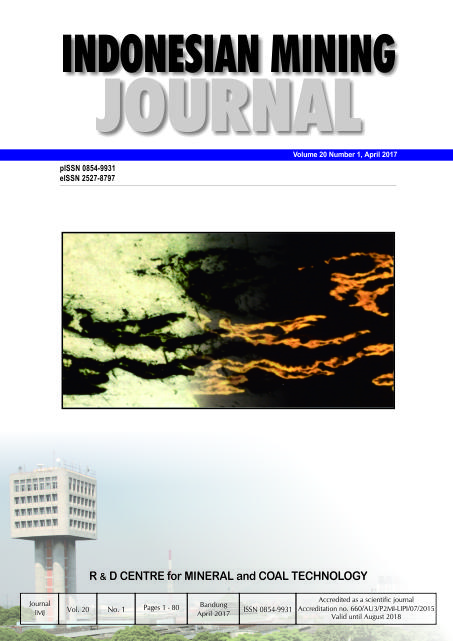EXTRACTING SILVER FROM ANODE SLIME AFTER LEAD AND GOLD SEPARATIONS
DOI:
https://doi.org/10.30556/imj.Vol20.No1.2017.180Keywords:
anode slime, silver recovery, silver extraction, chlorination processAbstract
Anode slime, a byproduct from the process of copper electrorefining into the copper cathode, contains several valuable elements that can be extracted after Cu and Pb separations. Another alternative route for extracting the precious metals is still needed in terms of gaining more economical route. This research aims to seek the new route to extract the precious metals, especially silver from anode slime. In these experiments, the anode slime was obtained from PT Smelting Gresik. The lead was separated to produce the residue which was then chlorinated to extract the gold. Later the residue was used for extracting the silver by dissolving it in ammonium hydroxide solution with varying time dissolutions and concentrations and later dissolving in hydrochloric acid to form silver chloride which was reduced to metallic silver. These experiments had two trials. The first one related to directly using residual chlorination after gold separation and the second one employed the same residual chlorination but processed through de-chlorination by adding sodium carbonate. The result showed that the highest silver recovery of 53.56% related to 5 M ammonium hydroxide concentration, the temperature of 30°C, dissolution time of 60 minutes. Recovery of 53.78% was achieved at 7 M ammonium hydroxide, the temperature of 30°C, dissolution time of 60 minutes. The feed of those experiments came from direct residual chlorination, while chlorination residue that underwent de-chlorination produced silver recovery of 94.95% with leaching conditions of 5 M ammonium hydroxide, the heating temperature of 30°C and leaching time of 60 minutes. The latest recovery was relatively high resulted in the process could be scaled up to a continuous system.References
Aktas, S. (2010) “Silver recovery from spent silver oxide button cells,” Hydrometallurgy, 104(1), pp. 106–111. doi: 10.1016/j.hydromet.2010.05.004.
Backstrom, J. (2010) Copper, nickel and tellurium yields during leaching of anode slimes. Lulea University of Technology.
Bard, G. N. and Sobral, and L. G. S. (2008) “Extraction of gold, silver and copper from the copper electrorefining anode slime: separation of the metals,” in Mishra, B., Ludwig, C., and Das, S. (eds.) REWAS 2008 Global Symposium on Recycling, Waste Treatment and Clean Technology. Mexico: TMS (The mineral, Metals and Materials Society), pp. 142–148.
Bigum, M., Brogaard, L. and Christensen, T. H. (2012) “Metal recovery from high-grade WEEE: A life cycle assessment,” Journal of Hazardous Materials, 207–208, pp. 8–14. doi: 10.1016/j.jhazmat.2011.10.001.
Chen, A., Peng, Z., Hwang, J.-Y., Ma, Y., Liu, X. and Chen, X. (2015) “Recovery of silver and gold from copper anode slimes,” JOM, 67(2), pp. 493–502. doi: 10.1007/s11837-014-1114-9.
Chen, T. T. and Dutrizac, J. E. (2004) “Gold in the electrorefining of copper and the decopperizing of copper anode slimes,” JOM, 56(8), pp. 48–52. doi: 10.1007/s11837-004-0182-7.
Ernst Runyon G and E, H. J. (1972) “Recovery of silver from electrolytic copper refinery slimes.” United State of America.
Hait, J., Jana, R. K., Kumar, V. and Sanyal, S. K. (2002) “Some studies on sulfuric acid leaching of anode slime with additives,” Industrial & Engineering Chemistry Research, 41(25), pp. 6593–6599. doi: 10.1021/ie020239j.
Hait, J., Jana, R. K. and Sanyal, S. K. (2009) “Processing of copper electrorefining anode slime: a review,” Mineral Processing and Extractive Metallurgy, 118(4), pp. 240–252. doi: 10.1179/174328509X431463.
Harangi, Z., Kulcsar, T. and Kekesi, T. (2015) “Hydrometallurgical processing of anode slimes obtained from the electrolytic refining of soldering scrap,” Materials Science and Engineering, 40(1), pp. 64–74.
Kilic, Y., Kartal, G. and Timur, S. (2013) “An investigation of copper and selenium recovery from copper anode slimes,” International Journal of Mineral Processing, 124, pp. 75–82. doi: 10.1016/j.minpro.2013.04.006.
Rodliyah, I., Ardha, N., Saleh, N. and Mubarok, Z. (2011) “Leaching the lead from anode slime by ammonium acetate solution,” Indonesian Mining Journal, 14(3), pp. 123–132.
Rodliyah, I., Nuryadi Saleh, Ardha, N. and Mubarok, Z. (2013) “Effect of oxidizing agents in extracting gold from anode slime,” Indonesian Mining Journal, 16(3), pp. 154–161.
Wang, S., Wesstrom, B. and Fernandez, J. (2003) “A novel process for recovery of Te and Se from copper slimes autoclave leach solution,” Journal of Minerals and Materials Characterization and Engineering, 2(1), pp. 53–64. doi: 10.4236/jmmce.2003.21005.
Wang, W. K., Hoh, Y.-C., Chuang, W.-S. and Shaw, I.-S. (1981) “Hydrometallurgical process for recovering precious metals from anode slime.” United State of America.
Downloads
Published
Issue
Section
License
Indonesian Mining Journal provides immediate open access to its content on the principle that making research freely available to the public to supports a greater global exchange of knowledge.

This work is licensed under a Creative Commons Attribution-NonCommercial 4.0 International License.













